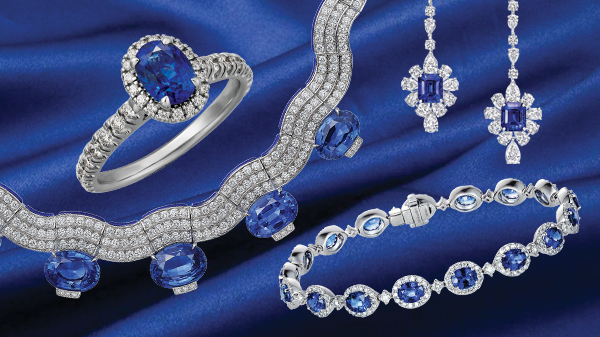Ever since the intrepid Etruscans first happened upon sapphires back some time around 700 BC, these lustrous blue-hued stones have been, for many, the most precious of jewels. Throughout history, various cultures have been convinced these dazzling gems possess qualities of a mystical nature. The Ancient Romans, for instance, sported them as a means of warding off evil, while the medieval Europeans swore by them as a way of curing eye maladies and even as a means of preserving chastity.
[{"id" : "55345","image" : "https://www.gafencushop.com/wp-content/gallery/2021-jan-jewellery/Azure-Bet-magnificent-Sapphires-gafencu-magazine-Chopard-Red-Carpet-Collection-2020-Heart-necklace.jpg","caption" : "Azure Bet magnificent Sapphires gafencu magazine Chopard Red Carpet Collection 2020 Heart necklace"},{"id" : "55348","image" : "https://www.gafencushop.com/wp-content/gallery/2021-jan-jewellery/Azure-Bet-magnificent-Sapphires-gafencu-magazine-Hirsh-London-bracelet.jpg","caption" : "Azure Bet magnificent Sapphires gafencu magazine Hirsh London bracelet"},{"id" : "55350","image" : "https://www.gafencushop.com/wp-content/gallery/2021-jan-jewellery/Azure-Bet-magnificent-Sapphires-gafencu-magazine-Roberto-Coin-Princess-Flower-bracelet.jpg","caption" : "Azure Bet magnificent Sapphires gafencu magazine Roberto Coin Princess Flower bracelet"},{"id" : "55352","image" : "https://www.gafencushop.com/wp-content/gallery/2021-jan-jewellery/Azure-Bet-magnificent-Sapphires-gafencu-magazine-Peonia-Starlight-Ring.jpg","caption" : "Peonia Diamond Nov 17"},{"id" : "55354","image" : "https://www.gafencushop.com/wp-content/gallery/2021-jan-jewellery/Azure-Bet-magnificent-Sapphires-gafencu-magazine-Peonia-Starlight-Necklace.jpg","caption" : "Peonia Diamond Nov 17"},{"id" : "55356","image" : "https://www.gafencushop.com/wp-content/gallery/2021-jan-jewellery/Azure-Bet-magnificent-Sapphires-gafencu-magazine-Graff-sapphire-and-diamond-bracelet_p.jpg","caption" : "Azure Bet magnificent Sapphires gafencu magazine Graff sapphire and diamond bracelet_p"},{"id" : "55358","image" : "https://www.gafencushop.com/wp-content/gallery/2021-jan-jewellery/Azure-Bet-magnificent-Sapphires-gafencu-magazine-Graff-sapphire-and-diamond-earrings.jpg","caption" : "Azure Bet magnificent Sapphires gafencu magazine Graff sapphire and diamond earrings"},{"id" : "55360","image" : "https://www.gafencushop.com/wp-content/gallery/2021-jan-jewellery/Azure-Bet-magnificent-Sapphires-gafencu-magazine-Cartier-SurNaturel-High-Jewellery-Sinop%C3%A9-earrings.jpg","caption" : "Azure Bet magnificent Sapphires gafencu magazine Cartier [Sur]Naturel High Jewellery Sinopé earrings"},{"id" : "55362","image" : "https://www.gafencushop.com/wp-content/gallery/2021-jan-jewellery/Azure-Bet-magnificent-Sapphires-gafencu-magazine-Cartier-SurNaturel-High-Jewellery-Sinop%C3%A9-necklace.jpg","caption" : "Azure Bet magnificent Sapphires gafencu magazine Cartier [Sur]Naturel High Jewellery Sinopé necklace"},{"id" : "55364","image" : "https://www.gafencushop.com/wp-content/gallery/2021-jan-jewellery/Azure-Bet-magnificent-Sapphires-gafencu-magazine-Cartier-Destinee.jpg","caption" : "Azure Bet magnificent Sapphires gafencu magazine Cartier Destinee"}]
(Peonia Starlight ring and necklace; Chopard Red Carpet Collection 2020 Heart necklace; Hirsh London bracelet; Roberto Coin Princess Flower bracelet)
Derived from corundum – the world’s second hardest mineral after diamond – they take their name from the Latin word for blue: “saphirus”. This, though, despite being seemingly apt, is actually something of a misnomer, as although they are most frequently associated with that particular pastel, they can be found in a wide variety of colours depending on the specific combination of impurities within the mineral. Traces of iron, for instance, can render the stone yellow or green, while a combination of iron and titanium results in more of an azure hue. Interestingly, rubies are also a corundum varietal, with their red bodies directly down to flecks of chromium in the corundum.
(Cartier [Sur]Naturel High Jewellery Sinopé necklace and earrings; Cartier Destinée ring; Graff sapphire and diamond earrings and bracelet)
Today, sapphires remain at the heart of many of the most celebrated jewellery items. Both versatile and breathtaking, they shine in Cartier’s [Sur]Naturel High Jewellery Sinopé elegant diamond-and-sapphire combination, yet manage to retain an aura of understated sophistication in haute joaillerie maison Graff’s bracelet-and-earring set.



